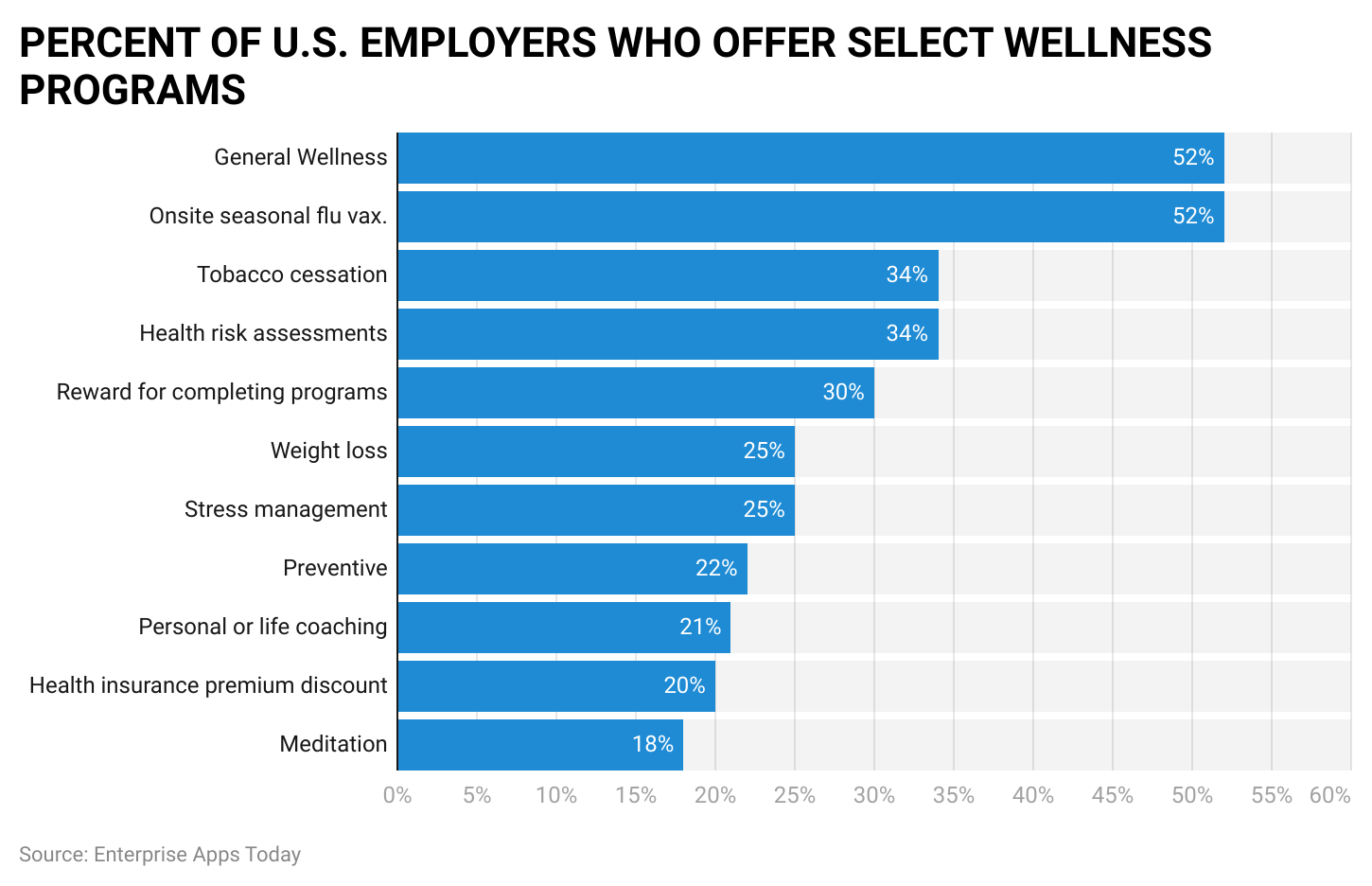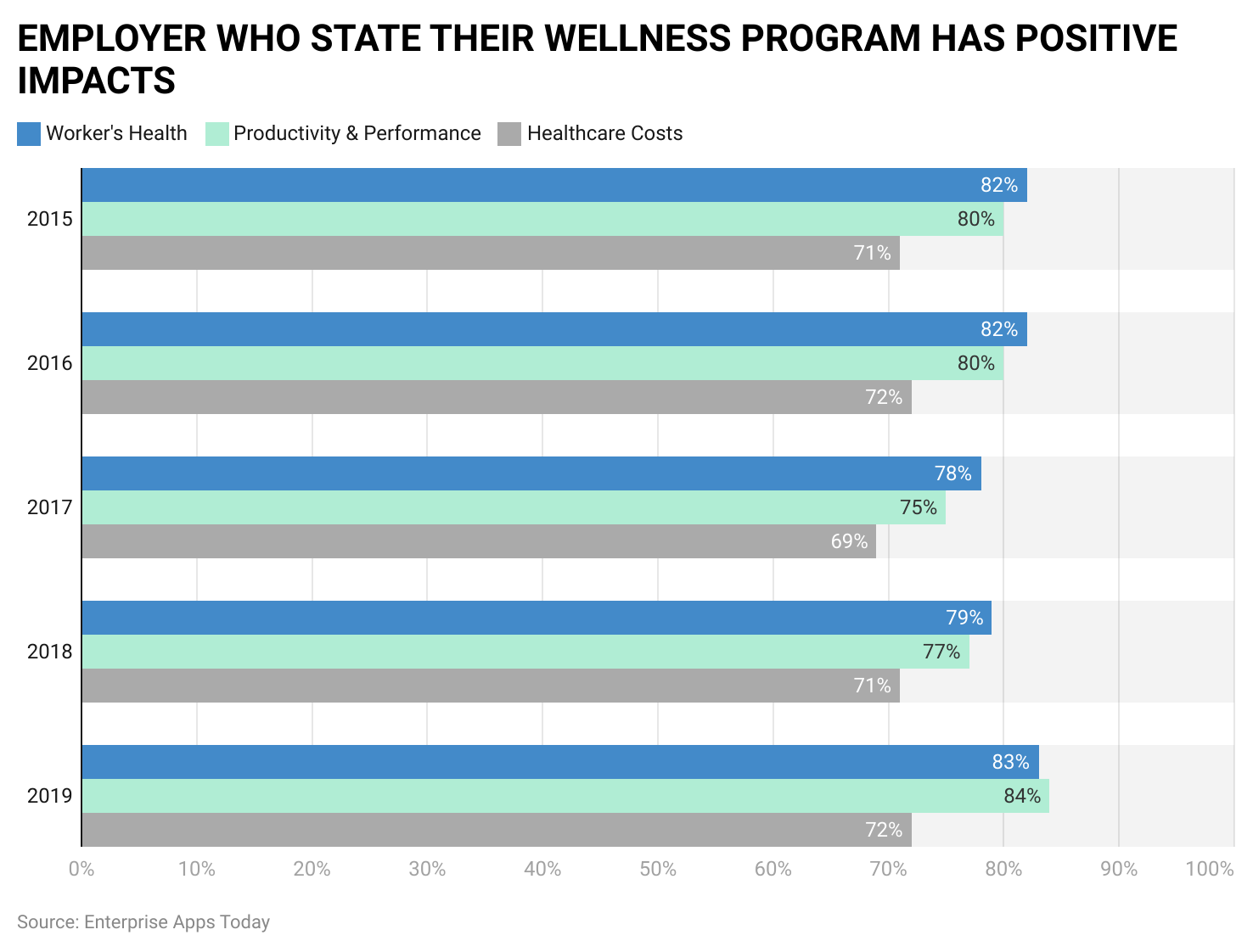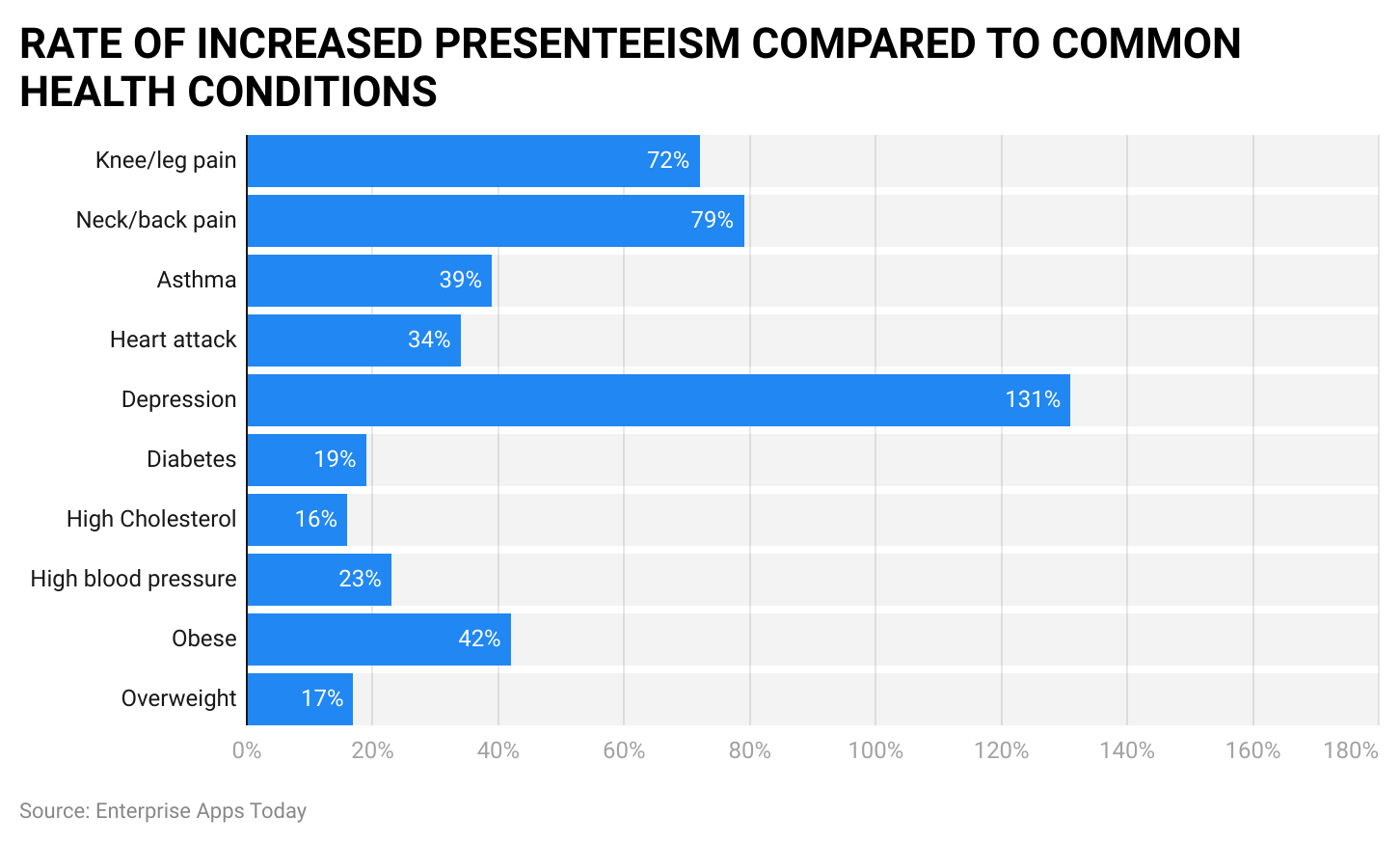25+ Employee Wellness Statistics For 2023 – See How Workplace Wellness Programs Are Improving!

Page Contents
Employee Wellness Statistics: More companies across the globe are implementing wellness programs for their employees, which benefits both parties, such as employers and employees. This article will discuss the facts and key statistics on employee wellness.
Key Employee Wellness Statistics (Editor’s Choice)
- More than 80% of workers whose employers are involved in their wellness say that they love their jobs.
- 56% of employees who participate in company wellness programs report that they are less sick because of these programs.
- One study found that 57% of employees with high health risks reduced their risk after completing a program of exercise provided by their employers.
- After implementing a wellness program at the workplace, around 72% of employers noticed a decrease in healthcare expenses.
- 52% of the United States companies provide wellness programs.
- Wellness programs have decreased absenteeism from 14% to 19%.
- Businesses with 5,000 or more workers are most likely to deliver wellness programs.
- 83% of large businesses offer wellness programs.
- Six-to-one is the average ROI (return on investment) for employee wellness programs.
- As of 2023, only 52% of companies offer wellness programs.
- According to Employee Wellness Statistics, such programs increase morale and productivity.
- The companies that offer wellness programs have reported a 66% increase in overall productivity.
- During employee wellness research, the report found the following factors that could make an employee happy:
- Remote work option (33%), flexible work hours (41%), 4 days work week (31%), and A workplace that respects time off of the employees.
Why employee wellness programs are important?
- Increases overall productivity.
- Enhances company image in the marketplace.
- Increases employee retention rate.
- Improves morale and engagement
- Reduces stress level
- Reduces healthcare costs as well as unplanned leaves
- Attracts new talent
- Overall improves the company culture
Statistics By Employee Benefits
#1. More than 80% of workers whose employers are involved in their wellness say they love their jobs.
Approximately 85% of respondents say they plan to remain at their job.
On the other hand, roughly 40% of those whose employers don't care about their wellness say they enjoy their jobs, and 58% of people say they plan to continue working for their current employer.
#2. 56% of employees participating in company wellness programs report that they are less sick because of these programs.
These workers aren't just showing up to work more frequently; around 60% of respondents claim to be more productive when they work as well.
Additionally, 30% of people claim that they had a disease detected through these programs. This allowed them to start treatment before the disease progressed.
#3. One study found that 57% of employees with high health risks reduced their risk after completing a program of exercise provided by their employers.
In this study, the workers who were previously deemed high-risk (due to blood pressure, body fat, high levels of anxiety, etc.) turned low-risk after just six months of working with professionals who put them through exercise and cardiac rehabilitation programs.
These programs were funded by their company and held at their place of employment, so there were no barriers to participation.
#4. Employees who don't consistently exercise are 50% more likely to have excessive presenteeism than those who exercise regularly.
This is presenteeism when employees show up for work but aren't necessarily productive. An example of presenteeism is an employee who is unwell and comes to work but only checks email and surfs the internet. While they might not be absent, they also aren't productive.
Furthermore, employees who exercise on a regular basis are less likely to have high presenteeism, which increases productivity and business outcomes. The benefit of a corporate wellness program is that many of these programs encourage workers to exercise regularly.
Statistics By Frequency of Wellness Programs
#5. According to 2018 statistics, 37% of employers claim that they have integrated health promotion into their company culture.
This represents a considerable decline from 2017 and 2016 when 46% of employers had the same sentiment.
#6. As of 2018, 51% of companies offered health screenings to their staff.
A decrease from 59% in 2017.
Additionally, around 44% of firms provide health education, nearly 39% of companies provide links to employee services relevant to health and wellness, and 46% of businesses claim to offer a supportive social and physical environment for health improvement.
#7. 52% of American businesses provide a wellness program.
Around 20% of businesses give health insurance premium discounts for participation, and 30% of firms offer bonuses or rewards for completing health and wellness programs.

(Source: zippia.com)
Statistics By Employer Benefits
#8. Wellness programs have been demonstrated to decrease absenteeism from 14% to 19%.
Some businesses experience even more significant declines after introducing wellness programs: General Electric, for instance, saw a 45% decrease in absenteeism because of wellness programs.
#9. In 2019, 84% of firms indicated that wellness programs had increased employee performance and productivity.
This is an increase from 77% who stated the same in 2018 and 75% who expressed the same in 2017. In 2015 & 2016, around 80% of respondents said they experienced increased performance and productivity.
#10. On average, businesses that offer wellness programs typically get a six-to-one ROI (return on investment).
This was primarily evident in reduced health or medical care expenditures and reduced absenteeism rates, which allowed businesses to make financial savings and cover the cost of wellness programs.
#11. In 2019, 72% of companies claimed that the adoption of wellness initiatives resulted in a decrease in healthcare costs.
This rate was just 69% in 2017, a steady increase over the past two years.
#12. In 2019, 83% of businesses claimed that the wellness programs at their organizations had improved the health of their employees.
Only 78% and 79% of respondents in 2017 and 2018 reported increases, compared to 82%, in 2015 and 2016, respectively.

(Source: zippia.com)
Statistics By Company Size
#13. Businesses with 3 to 49 employees are less likely to offer wellness programs.
Only 57% of these companies provide health and wellness programs to their staff. This is a remarkable number considering the small number of employees.
Businesses with 50 to 199 workers are the second least likely to provide wellness programs, with only 70% doing so.
#14. 83% of large businesses offer wellness programs.
For these Employee Wellness Statistics, the term “big companies” refers to businesses having 200 or more employees.
#15. Businesses with 5,000 or more workers are most likely to deliver wellness programs.
Around 94% of these companies provide employee wellness programs, followed by nearly 92% of businesses with 1,000 to 4,999 employees.
#16. 58% of small businesses have wellness programs.
In this context, a “small firm” is a company with between three and 199 employees.
Statistics By Worker Opinions
#17. 60% of CEOs think their organizations are empathetic towards their workers.
#18. 38% of HR executives believe their organizations support the physical health of their workers.
#19. 74% of workers claim that they would work more hours if their employer showed empathy.
#20. 17% of workers claim their employers have helped them manage their physical well-being.
#21. 24% of workers believe their employers care about them.

#22. Not all wellness programs can produce effective outcomes, but those that can and are effectively arranged for employees to outperform more than others.
Studies also demonstrate that employees tend to have better health behaviors, which helps to alleviate depression and improve the situation. Their diet consists of only healthy foods, regular exercise, small portions, fewer drinks, and a smoke-free lifestyle.
Furthermore, the Heart Association in the US has completed a thorough analysis to evaluate the potential of wellness programs to contribute to health improvement and lower cardiovascular risk.
#23. According to the New England Journal of Medicine report, the risk of heart attack decreases by 2% to 3% for each 1% drop in total cholesterol.
For every one-point decrease in the elevation of diastolic blood, the risk of heart disease is lowered to between 2% and 3%.
#24. According to a study from the Journal of Population Health Management, several findings like these demonstrate presenteeism's presence.
Smokers were over one-fourth more likely to have excessive presenteeism than non-smokers. In contrast to those who consumed whole grains, vegetables, and fruits more frequently, workers with unhealthy diets were suggestively 66% more likely to have high presenteeism.
#25. In contrast to healthy workers, workers who are ill account for 15% of the world's economic output. According to the data, an unhealthy employee contributes a stunning 12% of the GDP or an enormously expensive $2.2 trillion annually.
- Work-related illnesses and injuries: – $250 billion.
- Chronic illness: – $1.1 trillion.
- Work-disengagement cost: – $550 billion.
- Work-related stress: – $300 billion.
Conclusion
Employee wellness programs are becoming increasingly popular, with 52% of American businesses offering wellness programs of a specific nature. These programs benefit workers, as is seen in the 56% of those participating in these programs, which have fewer sick days, and around 80% of people say they enjoy their work. Employers can't deny the benefits of offering wellness programs: 72% of businesses reported lower healthcare expenditures following the implementation of a wellness program, and 84% reported increased productivity and performance.
Companies often see a six-to-one return on investment (ROI) from employee wellness programs, earning $6 for every $1 invested. This is primarily due to the wellness programs' ability to lower medical care expenditures and absenteeism rates.
Sources
FAQ.
Wellness is important at work as employees must be healthy to be happy and productive. Even the most devoted worker will burn out or become ill if they don't care about their health; therefore, encouraging them to prioritize their well-being can help prevent this.
Additionally, less productive employees will be more engaged and effective when they are healthy, and demonstrating care for your staff members will enhance their performance and job satisfaction.
Many employees have attributed weight loss, early diagnoses, and improved physical fitness to their employers' wellness programs. Moreover, 80% of those who work for organizations with effective wellness programs say they enjoy their jobs.
Therefore, encouraging wellness in the workplace is in the best interests of both employers and employees.
Employers can help their staff members live healthier lives by implementing workplace wellness programs. These may be designed to encourage workers to prioritize their health, make access to medical care easier for employees, or assist workers in their efforts to get and stay healthy.
The majority of organizations that provide well-being programs incorporate all these components to some extent. Some may award cash rewards to employees who log a particular amount of activity hours. In contrast, others may host flu disease or vaccination testing events and provide on-site workout classes and nutritious food options.
These wellness initiatives clearly benefit the employees; however, they also help the business because happy, healthy workers are typically more engaged and productive, which is good for the firm's bottom line.
Examples of workplace wellness programs include cash awards for completing a workout regime, access to an on-site gym or gym discounts, and on-site health screenings and flu vaccines.
Furthermore, workplace health programs can include steps like filling vending machines with nutritious snack options, allowing employees to work out on their own schedules, or connecting staff members with fitness professionals who can help them manage chronic conditions.
Numerous employers offer comprehensive health programs that may cater to the demands of a wide range of employees, regardless of whether they are already fitness experts or are just beginning to prioritize their health.
Businesses may enhance well-being at work by taking action to prioritize well-being. Providing resources and services that are meaningful and useful for employees entails paying attention to their feedback.
It doesn't matter how many resources you provide your employees if none of them are achieving their wellness needs and objectives.
Moreover, companies must integrate wellness initiatives into their corporate cultures in order to improve workplace well-being. Even the best program will be ineffective if staff members don't understand the value of wellness or don't feel encouraged to participate in the programs offered.

Barry is a lover of everything technology. Figuring out how the software works and creating content to shed more light on the value it offers users is his favorite pastime. When not evaluating apps or programs, he's busy trying out new healthy recipes, doing yoga, meditating, or taking nature walks with his little one.